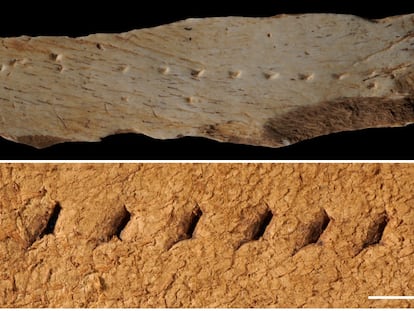Cecilia Charlton, the scientist who embroiders galaxies: ‘I hope to demonstrate the value of looking back and not always forward’
The American artist, who studied engineering, is inspired by science and the cosmos to create textiles full of color and history
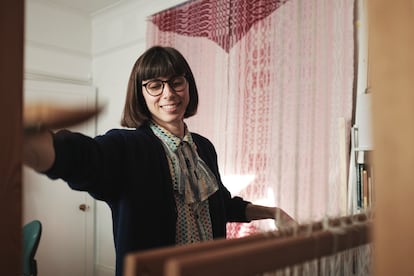
London-based American artist Cecilia Charlton creates embroidery and weavings that explores themes unusual for textiles, such as the cosmos, galaxies, human history and its transcendence in time. She interprets the universe through abstraction, geometric patterns and colors. Charlton’s work is that of someone who tried her hand at being a scientist, but ended up translating her knowledge into textiles. This fall, she will exhibit part of his work at the Monbull space in Spain’s capital.
The women of the Charlton family were constantly knitting. Cecilia, the middle of the three sisters, still remembers the sound of the needle going through the fabric, interspersed with snippets of conversation. “I miss that murmuring. Sometimes when I’m alone in the studio, I try to emulate it with the sound of the radio,” she told EL PAÍS. Cecilia Charlton’s upstate New York childhood revolved around textiles. Her grandmother earned a master’s degree in textiles, a rare feat for a woman at the time, and her mother inherited her deep passion and curiosity for knitting, pursuing it professionally: “They were obsessed with sewing, so I learned sewing from a very young age. We taught classes with the sewing machine, and my mother designed exercises for us to improve our skills. We created things like scrunchies and bags.”
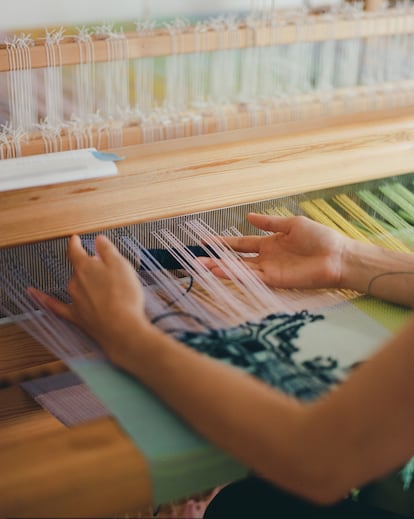
But the Charltons’ immeasurable love for sewing did not seem destined to transcend the walls of the house. Crafting was not an option at the time for the young Charlton. Her father was a scientist, and Cecilia was passionate about that world, which is why she began her engineering degree in 2005: “I didn’t know where I was going when I left engineering school, but I knew I had to go,” she explained. Although she considers herself a mathematical brain, her path turned towards Fine Arts to finish where she started, embroidering and incorporating love for science and the universe into the equation. She was awarded a BFA Painting in 2015 from Hunter College in New York and an MA in Painting from the Royal College of Art in London in 2018. Cecilia Charlton’s embroidery is not conventional. It seeks to reach places that separate her from her own history, where anthropocentrism is not the basis of existence. That is why she embroiders universes and galaxies: to break the spell of attachment to one’s own reality.
Her sources of inspiration include her bedside book The Pale Blue Dot by Carl Sagan, which describes the Earth in this way: “The Earth is a very small place in a vast cosmic setting. Think of the rivers of bloodshed by all those generals and emperors, so that, in their glory and triumph, they could become momentary masters of a fraction of a point.” Cecilia’s work yearns to find answers by looking beyond ourselves and our world.
How do you embroider a galaxy?
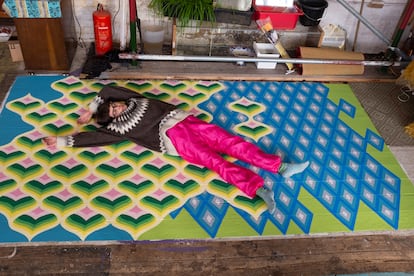
Charlton uses the bargello embroidery technique. The name comes from the Bargello palace in Florence, where a chair with this technique on its cushions was found. Another theory is that, when the palace was a prison, prisoners used to create bargello embroidery to sell. The technique can be seen in different parts of the world, so its origin is a mystery. “What I like about working with this technique is that, with relatively simple parameters, very complex patterns can be created. The bargello is based on three principles: the length of the point, the grouping of points and the use of color. Once you understand how these principles work in patterns, you can manipulate and shape existing patterns to use them in your own compositions,” explains the artist.

Charlton considers this technique ideal for depicting outer space for several reasons, including the linguistic relationships between fabrics and space and the myth of the Three Fates, the three spinner sisters who wove the thread of life: “In embroidery, there’s also a sense of slow buildup: each image is created as the stitches assemble over time, similar to how molecules or planets form in the early phases of a galaxy.”
Color is another of the protagonists of Charlton’s work. She seeks to recreate the sensation of energy from another world. “By mixing contrasting colors and using large gradient areas, I expect the colors to act similar to images that can be seen from a telescope of distant nebulae or galaxies,” she says.
Science meets art
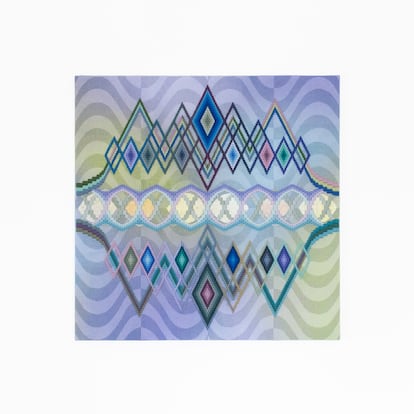
Society tends to see science as serious and art as frivolous, but Charlton maintains that there are more similarities than differences. What attracted her to engineering was the creative component and problem-solving. “In that sense, scientific research is very similar to artistic creation: trying to find a unique voice, learning to trust your intuition and feeling comfortable doing something differently from others. And, above all, the devotional nature of the task: you have to be driven by a deep curiosity, even if your experiments are not giving immediate results,” maintains the artist.
Cecilia Charlton also likes to use her work to discuss ideas around technology, because the embroidery she creates is a pixelated surface, similar to a computer screen: “Knitting is directly related to the development of computers. Human beings seem to have a blind spot when it comes to technology: they rush into the future not thinking about whether something should be done and only thinking about whether something can be done. With the weaving and embroidery techniques I use, I hope to demonstrate the value of looking back, not always forward.”
Sign up for our weekly newsletter to get more English-language news coverage from EL PAÍS USA Edition
Tu suscripción se está usando en otro dispositivo
¿Quieres añadir otro usuario a tu suscripción?
Si continúas leyendo en este dispositivo, no se podrá leer en el otro.
FlechaTu suscripción se está usando en otro dispositivo y solo puedes acceder a EL PAÍS desde un dispositivo a la vez.
Si quieres compartir tu cuenta, cambia tu suscripción a la modalidad Premium, así podrás añadir otro usuario. Cada uno accederá con su propia cuenta de email, lo que os permitirá personalizar vuestra experiencia en EL PAÍS.
¿Tienes una suscripción de empresa? Accede aquí para contratar más cuentas.
En el caso de no saber quién está usando tu cuenta, te recomendamos cambiar tu contraseña aquí.
Si decides continuar compartiendo tu cuenta, este mensaje se mostrará en tu dispositivo y en el de la otra persona que está usando tu cuenta de forma indefinida, afectando a tu experiencia de lectura. Puedes consultar aquí los términos y condiciones de la suscripción digital.
More information
Últimas noticias
Most viewed
- Sinaloa Cartel war is taking its toll on Los Chapitos
- Oona Chaplin: ‘I told James Cameron that I was living in a treehouse and starting a permaculture project with a friend’
- Reinhard Genzel, Nobel laureate in physics: ‘One-minute videos will never give you the truth’
- Why the price of coffee has skyrocketed: from Brazilian plantations to specialty coffee houses
- Silver prices are going crazy: This is what’s fueling the rally
